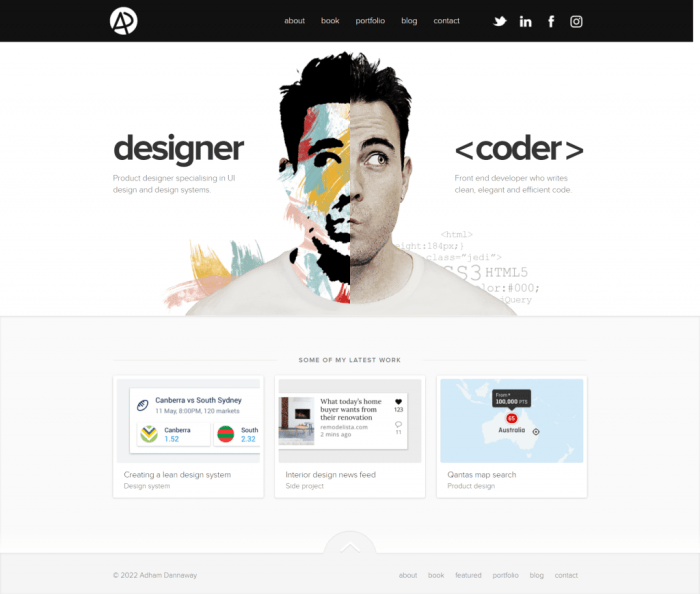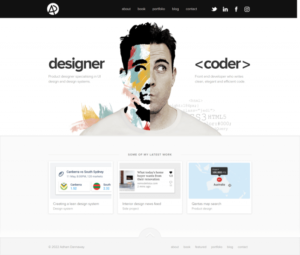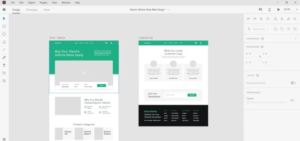
Kicking off with Web development portfolio projects ideas, this opening paragraph is designed to captivate and engage readers, setting the stage for a journey through innovative creations that showcase your skills. The world of web development is vast, offering numerous opportunities to demonstrate your expertise through unique projects that not only highlight your technical abilities but also enhance user experiences.
In this guide, we’ll explore a variety of project ideas that cater to different aspects of web development, from responsive design to integrating marketing elements. Whether you’re a beginner or an experienced developer, these concepts will help you create a compelling portfolio that stands out in today’s competitive landscape.
Web Development Portfolio Project Ideas
Creating a web development portfolio is crucial for showcasing skills and attracting potential clients or employers. A well-rounded portfolio should reflect proficiency in various technologies and design principles, capturing the essence of modern web development.
Innovative Web Development Projects
An effective portfolio should include a variety of projects that demonstrate a range of skills. Below is a curated list of 10 innovative web development project ideas:
- Personal Blog with CMS: Develop a personal blogging platform that allows for content management, user authentication, and commenting features.
- E-commerce Store: Create a complete e-commerce solution with product listings, shopping cart functionality, and payment integration.
- Portfolio Website: Design a visually appealing portfolio site to showcase your work, incorporating animations and transitions for an enhanced user experience.
- Social Media Dashboard: Build a dashboard that aggregates feeds from various social platforms, allowing users to manage their accounts in one place.
- Recipe Finder App: Develop an interactive web app that fetches recipes based on user-input ingredients, using APIs for real-time data.
- Weather Application: Create a weather forecast app that uses geolocation to provide users with real-time updates and forecasts for their area.
- Event Booking System: Design a platform for event bookings, featuring calendar integration and email notifications for users.
- Online Learning Portal: Build a platform for online courses that includes user registration, video hosting, and quizzes for assessment.
- Charity Fundraising Website: Create a site for a non-profit organization focused on fundraising, incorporating donation forms and impact tracking.
- Fitness Tracker: Develop a web application that allows users to log workouts, track progress, and set fitness goals.
Portfolio Layout Design
A modern web development portfolio should prioritize user experience and aesthetics. The layout must be clean, responsive, and easy to navigate, highlighting key projects prominently. Considerations for an effective layout include:
- Intuitive Navigation: Ensure that the menu is straightforward, allowing users to access information quickly.
- Visual Hierarchy: Use size, color, and spacing to guide users’ attention to important elements.
- Consistent Branding: Maintain a cohesive theme throughout the portfolio that reflects personal branding.
- Project Highlights: Feature selected projects with engaging descriptions and visuals to draw attention.
- Responsive Design: Implement a fluid grid layout that adjusts seamlessly across devices, enhancing user accessibility.
Importance of Responsive Design
Responsive design is essential in modern web development, ensuring that websites function well on a variety of devices and screen sizes. This approach enhances user experience, reduces bounce rates, and improves search engine rankings.Examples of responsive design principles include:
- Flexible Grids: Utilize CSS grid or flexbox to create layouts that adapt dynamically to different screen dimensions.
- Media Queries: Implement CSS media queries to apply styles based on the viewport size, ensuring optimal display on all devices.
- Fluid Images: Use scalable images that adjust to fit their containers, preventing distortion and ensuring clarity.
“Responsive design is not just about making things smaller; it’s about adapting to the user’s needs.”
Incorporating these elements into your projects will not only enhance the user experience but also demonstrate your adaptability as a developer in today’s diverse digital landscape.
Integrating Marketing Elements in Web Development
The integration of marketing elements in web development is crucial for creating a successful online presence. A well-designed website not only serves as a digital storefront but also acts as a powerful marketing tool. By incorporating effective marketing strategies into web projects, developers can enhance visibility, improve user experience, and ultimately drive conversions. This section will delve into essential strategies that include search engine marketing, website security, and social media integration to optimize web projects for better performance and marketing effectiveness.
Search Engine Marketing Techniques
Incorporating search engine marketing (SEM) techniques into web development enhances a website’s visibility in search engine results, driving traffic and increasing potential customer engagement. The strategies include the following:
- Optimization: Researching and integrating relevant s within the site’s content, meta tags, and descriptions ensures that the website is indexed correctly by search engines.
- Landing Page Design: Creating dedicated landing pages for specific campaigns or products improves user experience, focusing on conversion rates through effective calls to action.
- Quality Content Creation: Regularly updating the website with valuable, informative content not only attracts search engine algorithms but also builds authority and trust among visitors.
- Responsive Design: Developing a mobile-friendly website is essential, as search engines prioritize responsive sites for their accessibility and user experience.
Website Security and User Trust
Enhancing website security is paramount, as it directly impacts user trust and project success. A secure site reassures visitors about their data protection, fostering trust and encouraging engagement. Key security measures include:
- SSL Certificates: Implementing Secure Socket Layer (SSL) certificates encrypts data exchanged between users and the site, safeguarding sensitive information.
- Regular Software Updates: Keeping all software, plugins, and frameworks up to date prevents vulnerabilities that could be exploited by cybercriminals.
- Strong Password Policies: Encouraging the use of strong passwords and implementing two-factor authentication enhances user accounts’ security.
- Regular Backups: Regularly backing up website data ensures that information can be restored in case of a security breach or data loss.
Social Media Integration Benefits
Integrating social media into web development can significantly enhance promotional efforts and user engagement. A well-executed social media strategy amplifies reach, strengthens branding, and fosters community interaction. Important aspects of social media integration include:
- Social Sharing Buttons: Adding buttons for users to easily share content on their social platforms increases visibility and potential traffic.
- Embedded Feeds: Integrating live social media feeds can provide fresh content, keeping the website dynamic and engaging for visitors.
- Social Login Options: Allowing users to log in using their social media accounts simplifies the registration process, improving user experience and retention.
- Analytics Tracking: Utilizing tools to track social media engagement helps in analyzing user behavior and tailoring content to better meet their preferences.
Enhancing Visibility and Engagement

In the digital landscape, enhancing visibility and engagement is critical for the success of any web project. This involves leveraging various strategies to not only attract visitors but also keep them engaged with the content. The combination of video marketing, social bookmarking, and video streaming optimization plays a pivotal role in achieving these goals.
Implementing Video Marketing Strategies
Incorporating video marketing within web projects can significantly boost engagement levels. Videos are effective because they capture attention quickly and convey information in a digestible format. Here are several strategies to implement video marketing:
- Embed Videos: Including videos directly on your website creates a more interactive experience. Aim for short, high-quality videos that provide value to the viewer.
- Utilize Video : Optimize video titles, descriptions, and tags with relevant s to improve search engine visibility. This helps in attracting organic traffic.
- Create Shareable Content: Produce videos that encourage sharing across social media platforms. Engaging content, like tutorials or entertaining clips, can increase reach and visibility.
- Leverage Live Streaming: Engage your audience in real-time through live Q&A sessions, product launches, or behind-the-scenes content. This fosters a sense of community and immediacy.
Promoting Websites through Social Bookmarking and Networking
Social bookmarking and networking are vital for increasing website visibility and encouraging user interaction. By sharing links to your web pages on social bookmarking sites, you can drive targeted traffic. Below are effective methods for promoting websites:
- Choose the Right Platforms: Focus on popular social bookmarking sites like Reddit, Digg, or StumbleUpon. Each platform has a unique audience, so tailor your content accordingly.
- Create Compelling Titles and Descriptions: When bookmarking content, ensure that the titles and descriptions are engaging and accurately describe the content. This increases the chances of clicks.
- Engage with the Community: Actively participate in discussions related to your niche. Providing value through comments or responses can foster trust and encourage users to visit your website.
- Utilize Visuals: Incorporate eye-catching images or infographics when sharing bookmarks. Visuals can enhance engagement and entice users to explore your content further.
Optimizing Websites for Video Streaming
Improving user experience and retention in video streaming requires optimizing your website’s functionalities. Key methods for achieving this include:
- Ensure Fast Load Times: Optimize your video files for quicker loading. Use formats that balance quality and file size to enhance speed.
- Responsive Design: Implement a responsive design that adapts to various devices and screen sizes. This ensures users have a seamless experience regardless of how they access your content.
- Use Adaptive Bitrate Streaming: This technology adjusts the video quality based on the user’s internet speed, providing a smoother viewing experience without interruptions.
- Integrate Clear Navigation: Make it easy for users to find and access video content on your site. Utilize clear menus, search functions, and filters for better user experience.
Final Review

In conclusion, the right web development portfolio projects can significantly boost your professional presence, showcasing both your creativity and technical prowess. As you embark on these project ideas, remember that each creation is an opportunity to tell your unique story and connect with potential clients or employers. Stay inspired and keep building!
Popular Questions
What should I include in my web development portfolio?
Include diverse projects that showcase your skills, a brief description of each project, the technologies used, and the challenges faced.
How do I choose the right projects for my portfolio?
Select projects that highlight your strengths and interests, and ensure they demonstrate a range of skills.
Is it important to have a personal website for my portfolio?
Yes, a personal website acts as an online resume, allowing potential employers to easily view your work and contact you.
How can I make my portfolio stand out?
Focus on user experience, include interactive elements, and showcase unique projects that reflect your personal style.
Should I update my portfolio regularly?
Yes, regularly updating your portfolio with new projects and skills keeps it relevant and showcases your growth as a developer.





